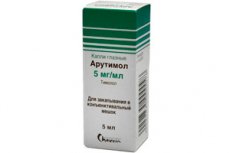阿鲁替莫尔
最近審查:04.07.2025

阿鲁替莫(又称噻吗洛尔)是一种常用于治疗青光眼和眼压升高的药物。青光眼是一种严重的眼部疾病,其特征是眼压升高,可能导致视神经损伤和视力丧失。
噻吗洛尔属于β受体阻滞剂类药物。它的作用原理是减少眼内房水的产生,从而降低眼压。这有助于降低视神经受损的风险,并保护青光眼患者的视力。
阿鲁替莫通常以眼药水的形式提供。通常每天使用1-2次,具体取决于医生的指示和患者的具体需求。与任何药物一样,使用阿鲁替莫前务必咨询医生,以确保其适合您的具体情况,并且不会引起不良副作用。
適應症 阿鲁蒂莫拉
- 开角型青光眼:这是最常见的青光眼类型,由于房水引流不畅,导致眼内压力升高。阿鲁替莫有助于降低眼压,从而防止视神经受损,保护视力。
- 窄角型青光眼:这是一种不太常见但较为严重的青光眼,其特征是由于虹膜和角膜之间的角度狭窄,导致房水排出不畅。在进行扩角手术并改善房水排出之前,可以使用噻吗洛尔来降低眼压。
- 局部或弥漫性角膜萎缩:有时建议使用阿鲁替莫来治疗这种以角膜厚度减少为特征的疾病。
- 无青光眼的眼压升高:在某些情况下,可以使用噻吗洛尔来降低无青光眼症状的眼压升高患者的眼压,以防止疾病发展。
- 开角型青光眼:这是最常见的青光眼类型,其特征是由于房水排出受限或阻塞导致眼压升高。噻吗洛尔有助于降低眼压,从而有助于防止视神经进一步受损并保护视力。
- 某些形式的高血压性眼病:有时可以使用噻吗洛尔来控制高血压性眼病患者的眼压。
發布表單
阿鲁替莫通常以眼药水的形式提供。眼药水通常采用特殊容器包装,以确保无菌且易于使用。通常,眼药水装在小瓶或塑料瓶中,并配有计量装置,方便精确计量。
藥效學
阿鲁替莫的主要活性成分噻吗洛尔的药效学与其阻断β-肾上腺素受体的能力有关。噻吗洛尔是一种直接、非心脏选择性的β-肾上腺素受体阻滞剂。
在眼部,噻吗洛尔通过减少房水的产生来降低眼压。该过程通过阻断眼部结构(例如睫状体根茎上皮)中的β-肾上腺素受体来实现,从而导致房水生成减少。
β受体阻滞剂还可以通过减少睫状体主动房水生成过程中的房水形成来减少眼内房水的分泌。这会导致眼压降低,这对于治疗青光眼和预防视神经损伤尤为重要。
噻吗洛尔通常以滴眼液的形式局部使用,直接作用于眼部,从而最大限度地减少全身副作用。然而,在极少数情况下,部分药物仍可能通过眼部吸收并产生全身作用,影响与β-肾上腺素受体相关的其他器官和组织,从而可能引起副作用。
藥代動力學
- 吸收:将噻吗洛尔滴眼液局部滴入眼部后,药物可经结膜和角膜吸收。然而,噻吗洛尔的全身吸收率较低,因为它主要停留在眼内,几乎不会穿透眼部屏障进入血液。
- 分布:噻吗洛尔被吸收到血液中,通常具有较高的分布容量,这意味着它可以迅速扩散到全身。
- 代谢:噻吗洛尔主要在肝脏中代谢,形成无活性的代谢物。主要代谢途径是通过CYP2D6酶进行氧化。
- 消除:噻吗洛尔代谢物和一些药物原型主要通过尿液排泄。噻吗洛尔主要以代谢物的形式从体内排出。
劑量和管理
- 剂量:成人常用剂量为将0.25%或0.5%的噻吗洛尔溶液滴入眼结膜囊,每日1至2次。但医生可根据病情严重程度和患者的个体情况调整具体剂量。
- 使用方法:使用眼药水前,请彻底洗手,以免污染眼睛。然后,将头向后仰或躺下,抬起眼睛,轻轻拉下下眼睑,形成一个容纳眼药水的囊袋。然后将一滴眼药水轻轻注入结膜囊,滴入后稍闭眼睛,以防止滴液泄漏。
- 坚持使用:为了获得最佳效果,即使没有症状,也应每天按照建议的剂量和时间使用眼药水。这有助于维持稳定的眼压,防止病情恶化。
在懷孕期間使用 阿鲁蒂莫拉
怀孕期间使用 Arutimol 应在医生的监督下进行,并且仅在有明确的医学指征的情况下,使用 Arutimol 的益处大于对母亲和胎儿的潜在风险。
迄今为止,关于妊娠期间服用噻吗洛尔的安全性数据有限,其对胎儿的影响尚未得到充分研究。目前尚无足够的孕妇临床对照研究来评估其对胎儿的风险。
与许多其他药物一样,噻吗洛尔可穿透胎盘屏障并影响胎儿发育。因此,应谨慎使用,并应在与医生仔细讨论后再使用。
禁忌
- 超敏性或过敏反应:已知对噻吗洛尔或该药物的其他成分有超敏性或过敏反应的人应避免使用该药物。
- 支气管哮喘或慢性阻塞性肺病 (COPD):噻吗洛尔作为一种β受体阻滞剂,可能导致哮喘或 COPD 患者的支气管收缩和呼吸功能恶化。因此,在没有严格医疗监督的情况下,此类患者禁用。
- 心血管疾病:噻吗洛尔可能会加重心力衰竭症状、加剧心律失常或导致心血管疾病患者的低血压。因此,一般不建议患有严重心血管疾病的人服用。
- 窦性心动过缓综合征:噻吗洛尔可能会导致窦性心动过缓综合征患者出现心动过缓(心率减慢)。
- 对CYP2D6酶抑制剂过敏:由于噻吗洛尔由CYP2D6代谢,因此对该酶抑制剂过敏的患者应避免使用或谨慎使用。
- 儿科人群:由于缺乏足够的安全性和有效性数据,噻吗洛尔在儿童中的使用可能会受到限制。
副作用 阿鲁蒂莫拉
- 应用部位反应:可能包括眼睛刺激、灼热、发红或发痒。
- 味觉变化:一些患者在使用噻吗洛尔滴眼液后可能会出现味觉变化。
- 心率减慢(心动过缓):噻吗洛尔可能会减慢心率,这可能会导致某些患者出现心动过缓。
- 低血压:噻吗洛尔可能会导致某些人的低血压。
- 眼睛干涩:有些患者可能会感到眼睛干涩、不适或有异物感。
- 头痛:患者使用噻吗洛尔后可能会出现头痛。
- 嗜睡:有些人使用噻吗洛尔后可能会感到嗜睡或疲倦。
- 消化问题:可能包括腹泻或恶心。
- 罕见的是,可能会出现严重的副作用,如过敏反应、支气管痉挛(气道变窄)、哮喘恶化、血管性水肿(斯图尔德-亚当斯水肿)、心律失常和其他心血管问题。
過量
- 副作用增加:如严重嗜睡、头晕、视力模糊、严重心动过缓(心率减慢)、头痛、恶心、呕吐等。
- 严重的心血管并发症:包括心律失常、心脏骤停和低血压。
- 呼吸系统并发症:呼吸功能恶化、支气管痉挛(支气管狭窄)、阻塞性呼吸道疾病。
與其他藥物的相互作用
- 降血压药物(抗高血压药物):将噻吗洛尔与其他抗高血压药物(如β受体阻滞剂、利尿剂或血管紧张素转换酶抑制剂)联合使用可能会导致血压进一步降低。
- 心血管药物:噻吗洛尔可能会增强抗心律失常药物(如阿米诺定)的作用,并导致严重的心律问题。
- 中枢抑制剂和催眠药:噻吗洛尔可能会增强中枢抑制剂和催眠药的抑制作用,从而导致嗜睡加重和呼吸抑制。
- 抗抑郁药和神经安定药:与噻吗洛尔联合使用时,抗抑郁药和神经安定药可能会增强其降压作用并增加直立性低血压的风险。
- 拟交感神经药:拟交感神经药与噻吗洛尔联合使用可能会导致其抗高血压作用降低。
- 单胺氧化酶抑制剂 (MAOI):噻吗洛尔与 MAOI 联合使用可能会增强抗高血压作用并增加严重副作用的风险。
注意!
為了簡化對信息的理解,本指令使用了藥物 "阿鲁替莫尔",並根據藥物的醫療用途官方說明。 使用前請閱讀直接用於藥物的註釋。
描述僅供參考,不適用於自我修復指導。 這種藥物的需求,治療方案的目的,藥物的方法和劑量僅由主治醫師確定。 自我藥療對你的健康有危害。

